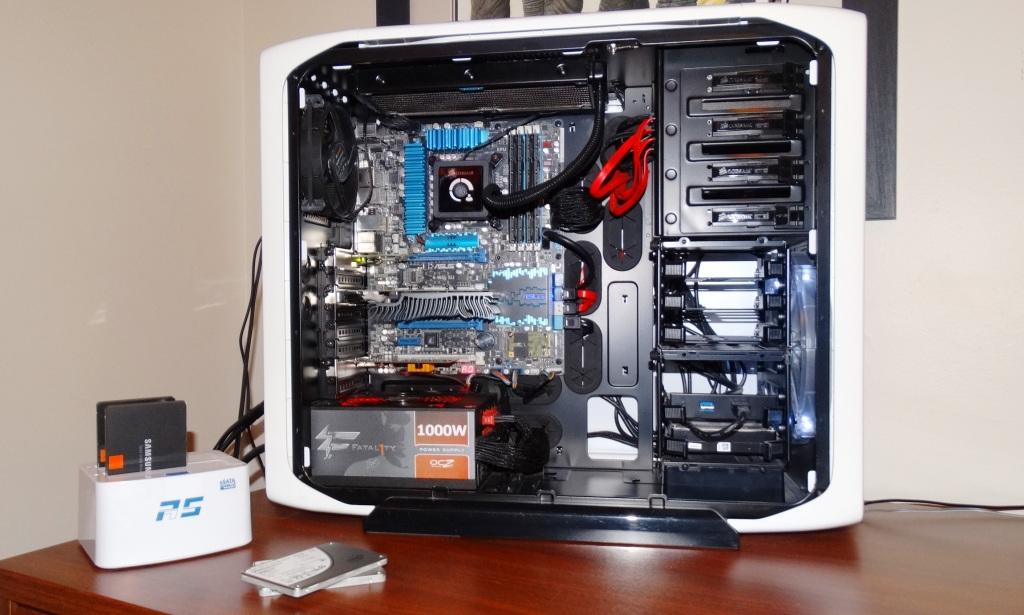TEST BENCH AND PROTOCOL
Our analysis today will be conducted with our Asus Z77 Premium Test Bench. Clicking on any pictures or benchmarks will bring up a more easily viewable high resolution image.
In testing, our main objective is to obtain results as pure and as accurate as possible and we want to ensure that no anomalies slip through. Simply put, we want to provide you with the absolute best results the tested hardware can provide. Repetition in testing is standard and, if necessary, we may conduct specific tests in Windows 7 ‘safe mode’ to ensure the OS has little to no influence on the end result.
In order to validate and confirm our findings, testing is supported by industry accepted benchmark programs. All results are displayed through capture of the actual benchmark for better understanding of the testing process by the reader.
We would like to thank ASUS (P8Z77-V Premium![]()
![]() ), Intel (Core i7-3770K
), Intel (Core i7-3770K![]() ), Crucial (Ballistix
), Crucial (Ballistix![]() ), Corsair (H100
), Corsair (H100![]() ) and Be Quiet (PSU/Fans) for supporting the build of our Z77 Premium Test Bench. In addition, we would also like to thank HighPoint for their contribution of the RocketStor 5322
) and Be Quiet (PSU/Fans) for supporting the build of our Z77 Premium Test Bench. In addition, we would also like to thank HighPoint for their contribution of the RocketStor 5322![]() , RocketRAID 2711
, RocketRAID 2711![]() and their External Mini-SAS to Esata cabling
and their External Mini-SAS to Esata cabling![]() . Through this configuration we are able to benchmark all notebook and mSATA SSDs, whereby achieving identical performance as a direct system connection, yet we simply hot swap from the external storage dock.
. Through this configuration we are able to benchmark all notebook and mSATA SSDs, whereby achieving identical performance as a direct system connection, yet we simply hot swap from the external storage dock.
BENCHMARK SOFTWARE
The software we will be using for today’s analysis is typical of many of our reviews and consists of ATTO Disk Benchmark, Crystal DiskMark, AS SSD, Anvil Storage Utilities and PCMark Vantage. We rely on these as they each have a way of supporting one another yet, at the same time, adding a new performance benchmark to the total picture. Much of the software is free and can be downloaded simply by clicking on the linked title.
Crystal Disk Info provides some excellent information about the SSD itself to include its health, product information, ‘power on’ information as well as the characteristics of the SSD. We can see that the SSD is capable of TRIM as it is not greyed out as with AAM.
Crystal DiskMark displays a healthy number of SMART attributes for the Extreme II SSD.
 The SSD Review The Worlds Dedicated SSD Education and Review Resource |
The SSD Review The Worlds Dedicated SSD Education and Review Resource | 


Finally a Marvell SSD with decent OP…about time!
Now that’s what i like to see!
Great performance up there with the top dogs!
That 4K numbers are on par with the summys!
Wait to see pricing here in Greece!
Thanks for the review!
where are your steady state benchmarks? testing for several hours under load? the other good review sites do it and its the only thing i look at. please add them!
Different sites have different methods of testing. Although we look very closely at steady state number for enterprise drives, we don’t feel this is a major factor with consumers. Our test methodology was determined after abreat deal of feedback with readers.
Hello, your Samsung 840 Pro 512GB SSD Review is dated September 24, 2012 and you gave it your Editor’s Choice award, with the final-awards-0211.png graphic.
The SanDisk Extreme II SSD Review on this page is dated June 26, 2013 and you also gave it your Editor’s Choice award, no graphic though. Which SSD currently has your Editor’s Choice award?
Thank you for pointing this out. The award seems to have vanished but will be back soonest.
Look at the current this thing draws: 1.6A at 5V would require two USB 3 ports or three USB 2 ports to power it in a portable case. It is only suitable for use in cases with external power or inside a computer.
And? Why would you expect otherwise.
SanDisk’s spec summary on their website says max write power is 5.0W (vs. 8), or 1A at 5V — still maybe a bit high. Typical “active” is spec’ed at 0.22W.